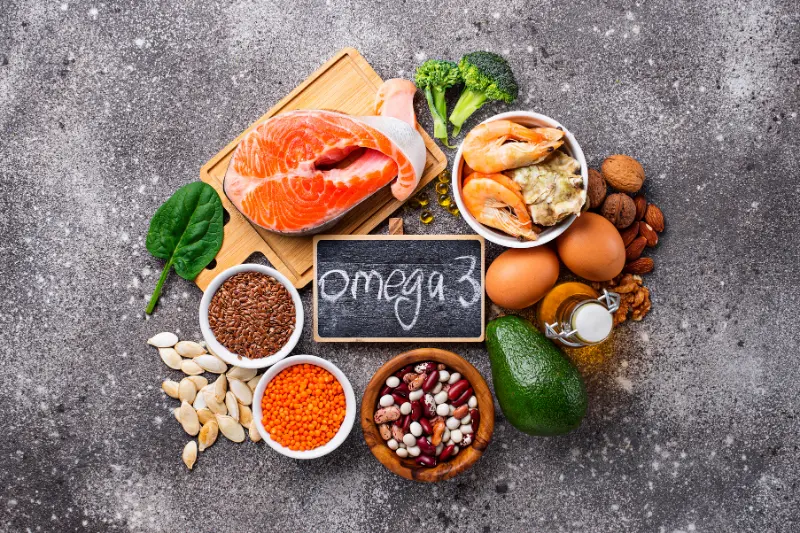For our health, omega-3 fatty acids can make an important contribution. Not only in fish, but also in plant-based alternatives, are valuable fats. Find out which foods are the best sources of omega-3 here.
Where are omega-3 fatty acids found, and which foods are the best sources of omega-3? We show you which foods you can use to meet your omega-3 needs.
Omega-3 fatty acids (foods)
Omega-3 fatty acids, such as eicosapentaenoic acid (EPA) and docosahexaenoic acid (DHA), are found primarily in foods that originate in the sea, such as fish and algae. Alpha-linolenic acid (ALA) is found mainly in plant foods.
Omega-3: Food List (Animal Sources)
Because of its high concentration of omega-3 fatty acids, fish is a particularly significant source of nutrients. Low-fat fish species such as pollock, cod, hake, plaice, and redfish provide between 280 and 840 milligrams of EPA and DHA per 100 grams of fish. High-fat species such as herring can even contain around 3000 milligrams of long-chain omega-3 fatty acids.
Omega-3: Food list (plant sources)
As an omega-3 substitute for fish, plant sources of omega-3 can also be added. Vegetable oils, for example, are wonderful for hot and cold cooking. Nuts and seeds are a wonderful addition to muesli, salads, and the like. One tablespoon of linseed oil provides about 2-4 grams of the omega-3 fatty acid ALA.
Algae oil has a special status as a vegetable source of omega-3, as it supplies the omega-3 fatty acids EPA and DHA, which are also found in marine fish. However, because algae oil is often offered in combination with other vegetable oils, the content can vary from 330 to 1820 mg of omega-3 (EPA and DHA) depending on the product.
Hemp oil, hemp seeds, and chia seeds are also among the foods rich in omega-3 fatty acids.
REMINDER
You should know about these foods rich in omega-3: fatty cold-water fish (e.g., anchovies, herring, and salmon), algae, and vegetable oils (e.g., flax oil).
Fish as a source of omega-3
Particularly valuable sources of omega-3 fatty acids are considered to be fatty cold-water sea fish such as salmon, herring, mackerel, tuna, sardines, or krill (small crustaceans). These fatty sea fish contain abundant EPA and DHA, which contribute significantly to meeting the need for essential omega-3 fatty acids.
However, the omega-3 content can vary depending on the fishing area and the type of fish. Just two portions of fish per week can ensure the omega-3 intake recommended by the DGE. It does not matter whether the fish is fresh, frozen, or canned. With gentle preparation methods and the single use of frying fats, only a small loss of fatty acids occurs.
Even though tuna provides valuable omega-3 fatty acids, it, like cod and hake, is often conspicuous for its high (methyl) mercury contamination and should therefore only be consumed in small quantities, also for reasons of sustainability.
REMINDER
Especially fatty sea fish provide high-quality omega-3 fatty acids such as EPA and DHA and can cover the need for omega-3.
Omega-3 – the ratio must be right
Important to the supply of polyunsaturated fatty acids is the fact that omega-3 and omega-6 fatty acids compete with each other due to their synthesis. Both need the same enzyme to be converted to EPA and DHA. Therefore, it is not only the absolute amount consumed that is important, but above all, the correct ratio to each other: one part omega-3 to five parts omega-6.
Omega-3 foods: frequently asked questions
- Where is omega-3 found? Canola, flax, and walnut oils are good sources of ALA. EPA and DHA are mainly found in fatty fish.
- Where is the most omega-3 in it? The high concentration of omega-3 fatty acids makes fish the most significant nutrient source of essential fats.
- Which fruits contain omega-3? Even though they hardly contribute to the supply due to their omega-3 content, the fatty acids can also be found in fruits such as avocado and berries.
- Which vegetables contain omega-3? Omega-3 fatty acids are also found in small amounts in vegetables such as spinach, Brussels sprouts, and beans.
- Where is omega-3 found (except in fish)? Although oily fish is considered a particularly high-quality source of omega-3, the fatty acids are also found in vegetable oils, nuts, seeds, and algae.
Knowledge to go
For our health, the valuable omega-3 fatty acids can make an important contribution. Omega-3 fatty acids are found in these foods: Fatty fish such as salmon, herring, mackerel, or anchovies provide plenty of omega-3 fatty acids. Plant foods such as algae, nuts, oils, and seeds are also important sources of omega-3.
